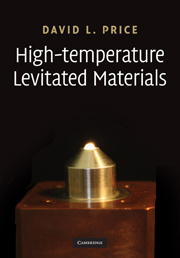1 - Scientific and technological context
Published online by Cambridge University Press: 23 April 2010
Summary
The present time appears appropriate for a monograph summarizing the current state of the art of investigation of high-temperature materials with levitation techniques. Although methods for levitating solid and liquid samples in a containerless environment have existed for the best part of the century – the patent for electromagnetic levitation dates back to 1923 – it is only in the past 20 years that their potential has been fully exploited by combining the levitation and heating aspects with new capabilities for structural and dynamic studies at synchrotron X-ray and high-flux neutron sources and refined techniques for thermophysical and transport property studies such as digital imaging, noncontact modulation calorimetry and electrodeless conductivity measurements. There has also been a rapid diversification in the types of levitation methods – aerodynamic, electromagnetic, electrostatic, and others – each of which have special advantages and disadvantages. The 2006 American Physical Society meeting in Baltimore, USA, featured a symposium of invited talks focusing on just one of these methods, electrostatic levitation combined with synchrotron X-ray studies.
Measurements of the structural, dynamical, thermophysical and transport properties of materials at high temperature are important in advancing condensed matter theory, in developing predictive models, and in establishing structure–property–process. Major experimental difficulties are encountered in obtaining reliable data on contained materials at temperatures above 1000 K owing to reactions of the samples with container walls and to the influence of the containers on scattering measurements. These problems are compounded when dealing with high-melting, corrosive liquids.
- Type
- Chapter
- Information
- High-Temperature Levitated Materials , pp. 1 - 2Publisher: Cambridge University PressPrint publication year: 2010

